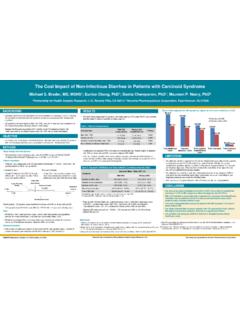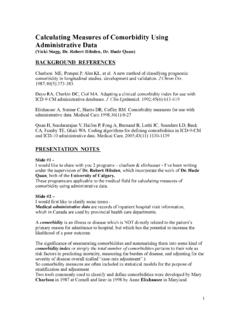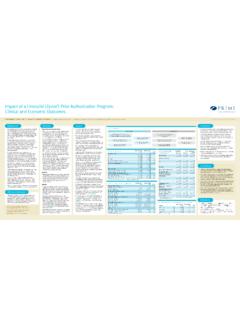Transcription of Adapting and Implementing an Evidence-Based …
1 Adapting and Implementing an Evidence-BasedTreatment with justice - involved Adolescents: TheExample of multidimensional Family TherapyHOWARD A. LIDDLE*, For over four decades family therapy research and family centered Evidence-Based thera-pies for justice - involved youths have played influential roles in changing policies andservices for these young people and their families. But research always reveals challengesas well as advances. To be sure, demonstration that an Evidence-Based therapy yields betteroutcomes than comparison treatments or services as usual is an accomplishment. But theextraordinary complexity embedded in that assertion feels tiny relative to what we are nowlearning about the so-called transfer of Evidence-Based treatments to real world practicesettings.
2 Today s family therapy studies continue to assess outcome with diverse samplesand presenting problems, but research and funding priorities also include studying partic-ular treatments in nonresearch settings. Does an Evidence-Based intervention work as wellin a community clinic, with clinic personnel? How much of a treatment has to change to beaccepted and implemented in a community clinic? Perhaps it is the setting and existingprocedures that have to change? And, in those cases, do accommodations to the contextcompromise outcomes? Thankfully,technology transfernotions gave way to more systemic,dynamic, and frankly, more family therapy-like conceptions of the needed science became the more sensible, as well as the theoretically andempirically stronger overarching framework within which the Evidence-Based family basedtherapies now operate.
3 Using the example of multidimensional Family Therapy, this arti-cle discusses treatment development, refinement, and implementation of that adaptedapproach in a particular clinical context a sector of the juvenile justice system : Evidence-Based treatment ; Juvenile justice ; adolescent Drug Abuse; multidimensional Family TherapyFam Proc x:1 13, 2014*Public Health Sciences and Psychology, University of Miami Miller School of Medicine, Miami, FL. Center for treatment Research on adolescent Drug Abuse, University of Miami Miller School of Medicine,Miami, concerning this article should be address to Howard Liddle, Center for TreatmentResearch on adolescent Drug Abuse, University of Miami Miller School of Medicine, clinical ResearchBuilding #1043, 1120 NW 14th Street, Miami, FL 33136.
4 E-mail: author is the developer of multidimensional Family Therapy (MDFT), and Chairman of the Boardof Directors of MDFT International, a 501(c) (3) public charity dedicated to the implementation of author acknowledges the contributions of Gayle Dakof, Cindy Rowe, and Craig Henderson to theDetention to Community study, as well as the research team, clinicians, community agency and juvenilejustice partners, and the adolescents and parents who participated in the research. The work reported wassupported by the National Institute on Drug Abuse, Grant U01 A16193 and R01 Process, Vol. x, No. x, 2014 2014 FPI, : doubt that there is an influence on the development of antisocial behavior among young peoplethat is stronger than that of the family.
5 (Steinberg, 2000)It is terrific when long-term collaborations are satisfying, productive, and mutually ben-eficial. Each of these outcomes has been achieved in the nexus of family therapy andthe specialties of substance abuse and antisocial behaviors (Stanton, 1979; Tolan, Crom-well, & Brasswell, 1986). Prescient, early family therapy s most influential projects(MacGregor, 1962; Minuchin, Montalvo, Guerney, Rosman, & Schumer, 1967; Stanton &Todd, 1982) addressed today s mandates studies of well-defined, theory-driven, clinicallyfeasible treatments that address common, complex, and pressing public health problemsin public sector settings (Southam-Gerow, Rodr guez, Chorpita, & Daleiden, 2012). Offer-ing treatment blueprints, promising outcomes, and no small dose of inspiration, the firstwave of family therapy research built a foundation that extended to four decades of sys-tematic treatment development.
6 Over those years, family centered treatments for youthdrug taking and delinquent behaviors joined the Evidence-Based practice movementthrough programmatic clinical trials ( , Henggeler & Sheidow, 2012; Rowe, 2012; vonSydow, Retzlaff, Beher, Haun, & Schweitzer, 2013). Individual approaches and the overallbody of empirical work gradually influenced service systems and policy even with clinical innovation and basic science knowledge interacting in these studies,favorable empirical data on family based treatment outcomes, high profile reports onsystem of care reform, and a growing youth and family advocacy movement, change inpractice is slow (National Research Council, 2013).Though deemed unacceptable in terms of an ultimate outcome, the rate of change hasbeen normalized by some as the nature of therapy and system reform clarifies.
7 The imple-mentation science specialty brings an empirical and dynamic systemic framework toevidence-based therapy development and dissemination (Craig et al., 2008). An imple-mentation focus relates to treatment development as process research does to outcomestudies. Process research is a necessary tool; it can illuminate therapy dimensions not visi-ble via other designs. Implementation inquiry does the same thing it reveals how andwhy an intervention program fits or fails in nonresearch settings (Fixsen, Blase, Naoom,& Wallace, 2009).Today s Evidence-Based treatment development contextualizes adaptation, refinement,and evaluation. For example , there is strong attention to study details, study quality perse ( , Becker & Curry, 2008; Sprenkle, 2012), as well as conflicting interpretations offindings from a single study or, usually via meta-analysis, from a set of studies (Kazdin,2013).
8 Controversies exist about program effectiveness (Drug and Alcohol Findings, 2014;Henggeler, Schoenwald, Borduin, & Swenson, 2006; Littell, 2006, 2008; Littell, Popa, &Burnee, 2005; Ogden & Hagen, 2006; The Campbell Collaboration, 2013), approachevaluations (discussed in Lindstr m et al., 2013; Gambrill & Littell, 2010; and van derStouwe, Asscher, Stams, Dekovi c, & van der Laan, 2014), transporting family based inter-ventions across cultures (Burkhart, 2013), trademarking and brand naming of establishedtherapies (Bean, 2012; Eisler, 2007; Imber Black, 2014), and the unavailability of evi-dence-based therapy training for most practitioners (Barth et al., 2011; Hogue,Henderson, Ozechowski, & Robbins, 2014).
9 And, these discussions inform suggestionsabout needed work. with this backdrop of contextual currents, there can be no doubt thatthe systematic adaptation of an Evidence-Based treatment to a new setting is , whether the treatment refinement and adoption concerns culture, family, or context,the field today seeks effective treatments that advance adaptation through systematic andempirical means without outcome PROCESSThis article uses the example of MDFT to describe implementation keys and treatmentdevelopment of an Evidence-Based treatment within a particular facet of criminal justice juvenile detention. First, to set the stage in orientation (Weisz & Hawley, 2002) andillustrative content (Holmbeck, Devine, & Bruno, 2010), we review briefly fundamentaland clinically informative aspects of the existing knowledge base on justice -involvedyouth, juvenile detention, and existing USEFUL, RESEARCH-DERIVED KNOWLEDGE ABOUTJUSTICE- involved ADOLESCENTSO verviewIn comparison with community samples, justice - involved youths show drasticallyhigher rates of overall health problems, mental health impairment, and psychiatric disor-ders.
10 These adolescents report heightened sexual activity, drug and alcohol use, proble-matic behaviors at school (aggressiveness, disobedience) and poorer academicperformance, interpersonal problem-solving skills and less family involvement. In clinicalsamples, comorbidity is normative. For instance, the link between juvenile criminaloffending and teen substance use is well documented the estimated prevalence of sub-stance abuse disorder and juvenile offending approaches 67% across studies in justice set-tings. Further, in a large study of juvenile detention center youths, nearly three quartersof girls and two thirds of boys have one or more psychiatric disorder (Teplin, Abram, Mc-Clelland, Dulcan, & Mericle, 2002).









